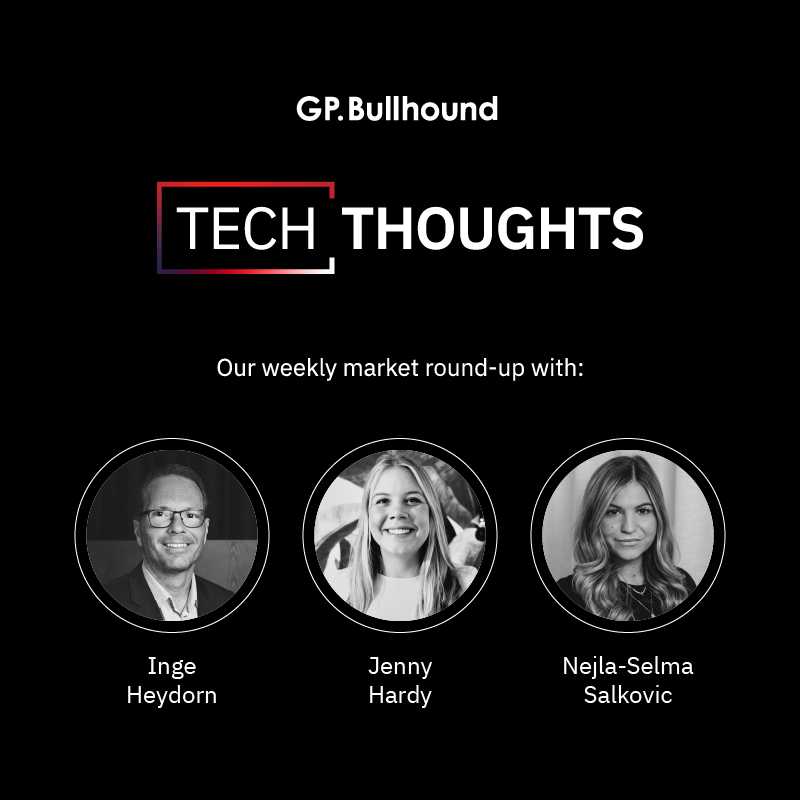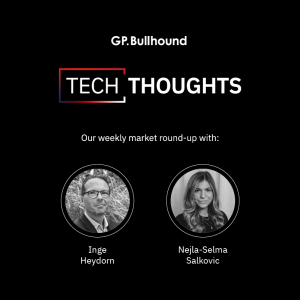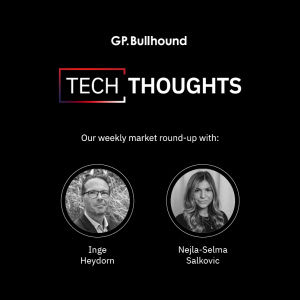Tech Thoughts Newsletter – 31 March 2023.

Market: The market volatility has declined somewhat this week with slightly better sentiment towards the banks. In tech this week we had a positive profit upgrade from our core holding Infineon. Memory player Micron (not owned) reported a horror Q2 writedown, but even there positivity prevailed, and the stock jumped 7% on comments that inventories were improving – again signs of optimism and investors looking to buy the last cut.
Portfolio: We added some Nvidia on weakness this week. We also added to our core positions in Infineon and NXP on the positive pre-announcement from Infineon, where it’s clear that semiconductor auto demand remains robust and where the supply/demand dynamics is creating a positive pricing environment, which we believe will persist.
Key takes:
Positive profit warning from core holding Infineon showing auto semis pricing power
- Infineon (owned) positively profit warned this week, raising guidance for Q2 revenues and margins (especially margins where it’s clear the pricing environment continues to be favourable).
- Management now expects Q2 revenue of €4bn (from €3.9bn) and high 20s margin vs 25%. For 2023 management now expects revenue to be meaningfully above the previously guided €15.5bn and a higher segment margin.
- We expect consensus 2023 EPS is now 15-20% too low for Infineon, so that it now trades at ~15x P/E – still attractive given the structural long term growth trajectory around content and its position as a market leader in power semis.
- Auto semis remains a supply constrained area and an area where there is clearly still positive pricing
- Relatedly, in Toyota’s monthly unit volume announcement this week, they stated the supply of semis into the sector is still tight.
Portfolio view: Autos remains the area we prefer to be exposed to in the semis/component space (we own Infineon and NXP), given the structural content increase in the move to EV and the barriers to entry around scale, technology and sticky customer relationships.
Micron weak but market might be anticipating the last downgrade
- There’s no getting away from Micron’s headlines numbers being weak. Q2 revenues were down 53% yr/yr and gross margin was negative 31% and net income we think reached an all time low, driven by negative pricing, inventory write downs and underutilisation charges.
- But equity markets are generally quite sophisticated – especially when it comes to semis – in buying the last cut – and that’s what the market did, after Micron gave colour that its customers inventories had finally been declining and that its own balance sheet DIO had peaked in Q2 and will continue to improve sequentially. The current quarter will still see a $500m inventory write down ($1.4bn this quarter – which is really what Micron failed to forecast last year and which caused the mega miss..)
- There is hope that AI demand (which we know is hugely memory and storage intensive) should drive a stabilisation of pricing but we’re not really seeing it yet. Management stated that an AI server has 8x the DRAM content of a regular server and 3x the NAND content.
- On each end market: PC unit volume is expected to be down mid single digit percentage in 2023 but inventories have improved “meaningfully”, with increased bit demand in H2; Mobile 2023 unit volume down slightly yr/yr and a mixed inventory situation with some back to normal and some remaining elevated. Auto revenue grew in Q2 and auto is expected to remain strong given increasing memory content per vehicle.
- The cross-over from DDR4 to DDR5 (AMD’s Genoa and Intel’s Sapphire Rapids require D5) is expected by mid 2024 in server and early to mid 2024 in PC.
- Micron cut capex expectations significantly through last year in an attempt to moderate industry supply and stabilise pricing, and the $7bn spend they had previously guided to was reiterated
Portfolio view: this memory downturn is the worst the market has seen in over 10 years. While much of this is the result of extraordinary circumstances (pandemic, inflation), some of it is also the nature of the industry – we don’t own any memory players in the portfolio as the commoditised nature and reliance on each player staying rational on supply means that for us it doesn’t match with our sustainable return on invested capital process. The mixed comments around smartphone inventory is an area to watch and we continue to prefer not to hold any direct PC/Smartphone semis exposure (and focus the portfolio instead on autos and industrial).
Limited new news on capex – we continue to expect a relatively weak year for memory spend but we increasingly think there’s upside risk of a stabilisation of DRAM spend helped by the AI build out.
Intel held its data centre and AI webinar – still behind but no more delays yet
- The biggest take for us in the webinar was that Intel’s latest process technology is actually ahead of schedule. The company has started sending samples of its Sierra Forest data centre chip – which will launch in the first half of 2024 – to customers, and is set to launch its Granite Rapids chip immediately after.
- It’s a significant change from the last several years of constant delays and disappointments and certainly a positive sign. Nevertheless, catching up after 10 years of underinvestment will take time and from a performance / power perspective, Intel remains far behind AMD. We’ve spoken before about AMD ultimately benefiting from TSMC’s process leadership – Intel needs to stay ahead of both which is no mean feat.
- Their (only?) significant customer for their deep learning chip solution so far seems to be Hugging Face (which was recently announced to be partnering with AWS). Intel is supplying its Gaudi GPU accelerators alongside Xeon CPU, as well as its “oneAPI” which they position as an alternative to CUDA.
- What’s interesting for the future product evolution is each of AMD, Nvidia and Intel having both CPU (for low level inference) and GPU (for dense large language model inference) capability, and being able to combine both in the compute of high performance AI workloads. It’s still not clear to us where the market will end in terms of a chiplet type solution mixing and matching Nvidia GPUs and AMD CPUs or a single provider solution. It’s also still not clear where the optimisation of workloads will end – Intel suggested that for small to medium AI models with under 10bn parameters, CPUs will perform best while for larger models GPUs/AI accelerators (talking their own story clearly on CPU but we think it’s fair to acknowledge that there are still a lot of uncertainties around the end state of AI/inference processing).
- We think Nvidia are still far ahead overall, given the leadership in GPU and the incumbency with CUDA.
- Nvidia’s GTC last week was full of logos across lots of parts of the industry/ecosystem – Intel pointing to one, quite small player who has taken their solution is probably telling us something.. And indeed, with Intel having disappointed on product for much of the last 10 years, it’s not straight forward why anyone would want to build reliance on them.
- AMD’s performance, energy efficiency and therefore total cost of ownership (TCO) advantage makes it a likely leader in CPU and certainly for datacentre workloads.
- It’s worth noting that Intel reiterated their Xeon 4 shipment view of 1 million units by mid year, while we know from their comments a few weeks ago at the Morgan Stanley conference that they continue to lose share – a positive read to AMD potential upscaled volumes.
- For ASML (owned) the reiterated timelines are significant because Sierra Forest is made on Intel 3, which is an EUV node (Intel 4 and 3 are Intel’s first EUV nodes).
- Comments around 18A being on track for 2025 were also positive for ASML – 18A will be using ASML’s latest EUV machines, High NA, which are capable of more accurate lithography. TSMC will also use High NA for its N2 technology. The latest update from them was in January where they guided for N2 to reach risk production in 2024 and volume production in 2025.
Portfolio view: we have to acknowledge lots of unknowns around how AI solutions will evolve, where the leadership will lie and what different chip solutions (chiplets etc) will look like. We own Nvidia and AMD on the GPU/CPU side given their clear leadership and the clear winning market share trajectory. On the process technology side, we own TSMC which remains the leader. TSMC’s historic ability to execute, its foundry business model (not competing with its customers) and the fact it has many years more experience in mass production with EUV are all clear tailwinds.
Intel’s return to leading edge manufacturing is totally dependent on it building up leading edge fabs and adopting EUV/High NA – which are already in ASML’s order books. It has (we think) only 1 EUV machine in production – which it shipped from the US – and maybe 1 more test/R&D tool. For context, we think (as a rough estimate) TSMC has about 80 tools in production. That’s an extraordinary level of catch up required – and we think Intel will be a significant driver of orders for ASML over the next 2-3 years. Intel is forced to invest to try to catch up for the last 10 years of underinvestment – we are sceptical as to whether it will succeed but will continue to benefit from it trying through ASML and the other semicap equipment names.
AI and search business model debate continues
- Microsoft is adding advertising to Bing’s AI powered chatbot: “We’re also exploring placing ads in the chat experience to share the ad revenue with partners whose content contributed to the chat response.” We’ve spoken before about the mismatch between revenues and costs in AI-powered search. Search doesn’t monetise per query – advertisers pay if and when a user clicks on an ad. That means the high incremental cost per query of adding inference capabilities (when the vast majority of those queries aren’t monetisable) results in a cost/revenue mismatch which is a fundamental issue.
- For Google, with its sheer scale of search queries, estimates suggest that using inference models which are extremely compute intensive would almost entirely destroy the profit pool of search (which is all of its business).
- For Bing, it looks like the costs of a still quite significantly smaller number of queries have reached levels they need to try to offset with ad revenue.
- Microsoft’s rationality in not trying to erode away the profit pool is probably good news for Google – who can do the same with Bard if that is the way that search evolves over time (though we’re still sceptical around whether search behaviour will change all that much).
Portfolio view: we own both Microsoft and Google. For Microsoft, we think much more interesting than Bing around AI is AI as an enterprise opportunity and the opportunity to upsell and monetise AI across its half a billion Office users – its enterprise AI event was we thought clearly one of the most impressive demonstrations of AI capabilities.
For Google, the reality is that Google’s 90% share is backed by multiple advantages: it’s been embedded in 20 years of habit; it dominates distribution across browsers and mobile, it pretty much invented many of the core technical capabilities around large language models which form the basis of chat interfaces; and it has much more data, and many more websites that are optimised around its search.
Gaming – PS5 and Hogwarts the standouts
- The US video game industry had a 6% increase in overall spending in February 2023 compared to the same period last year.
- Spending on video game content for the year-to-date period decreased by 2%. However, video game hardware spending increased 68% yr/yr. This is the highest video game hardware spend for a February month since the $534 million total reached in 2009.
- The standout game in February was Hogwarts, which we’ve spoken about in prior weeks, and Sony’s PS5 drove the hardware spend.
- Layoffs are continuing to affect various companies in the video game and broader tech industry, including Unity, Paradox, Disney this week, and Electronic Arts is laying off 6% of its workforce to focus on growth opportunities. No new surprises and we continue to think the bulk of tech is well placed (with high gross profit margins) to cut costs.
Portfolio View: The strong performance of Playstation is good news for Sony (owned) but also for AMD (owned) being sole supplier of the processor to Sony.
For weekly insights on the latest market updates, please subscribe to our Tech Thoughts podcast.
For more information about the latest trends and forecasts, please visit our official Tech Thoughts page.
We provide investors with access to category leading technology companies, globally. Our assets under management have a total value of more than $1bn, and our limited partners include institutions, family offices and entrepreneurs. Learn more about our funds here.
Enquiries
For enquiries, please contact:
Inge Heydorn, Partner, at inge.heydorn@gpbullhound.com
Jenny Hardy, Portfolio Manager, at jenny.hardy@gpbullhound.com
Nejla-Selma Salkovic, Analyst, at nejla-selma.salkovic@gpbullhound.com
About GP Bullhound
GP Bullhound is a leading technology advisory and investment firm, providing transaction advice and capital to the world’s best entrepreneurs and founders. Founded in 1999 in London and Menlo Park, the firm today has 13 offices spanning Europe, the US and Asia. For more information, please visit www.gpbullhound.com.

